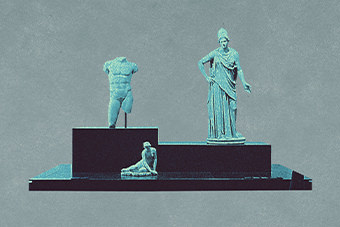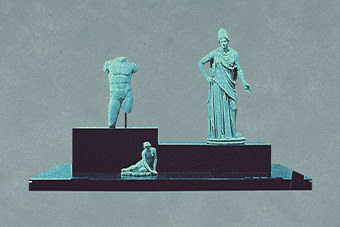The Kota Garh Museum, situated in the rambling palace complex on the banks of the Chambal in South-East Rajasthan is the most important tourist destination in Kota. The old city has three sets of concentric walls which have been built over time as the city has grown. The thickest and most recent set was built under the Dewan Zalim Singh in the early 19th century and forms some of the most impressive fortifications in India. The foundation of the fort can be traced back to 1264 and Kotah officially became a separate state from Bundi in 1624 under Rao Madho Singh, hence the name of the family trust which runs the Museum, Rao Madho Singh Museum Trust. The Trust was formed in 1970 at the initiative of M.K. Brijraj Singh under his father, Maharao Bhim Singh, with the object of setting up a museum to educate the public about the history of Kotah State and to preserve Kota’s heritage for future generations. (When referring to the erstwhile state and the royal family, Kotah is spelled with an ‘h’, while modern Kota post-independence is spelt without an ‘h’.)
Pandit Madan Mohan Shastri, who had just retired as curator of the Rajasthan State Museum in Kota, was instrumental in helping M.K. Brijraj Singh set up the museum. They were aided by Thakur Jaswant Singh and 1960, the Kota Barrage was built across the river Chambal right next to the Palace complex and some of the buildings were flooded and got damaged as a result.
The Garh had not been the primary residence of the royal family since Umed Bhavan Palace (now a Welcome Group Heritage Hotel) was built at the beginning of the 20th century, but it was regularly used for ceremonials and worship, particularly during Dusshera, the most important festival in the Kota calendar. Parts of the complex had been leased to schools and colleges and still are. The Government Museum was housed in the City Palace for some years, but moved out in the 1990s.
The Palace is most famous for its wall paintings, the best of which are in the Bada Mahal. The museum also has an excellent collection of silver howdahs and palanquins as well as royal memorabilia including garments, weapons, musical and astronomical instruments and games. The most prestigious item is the famous copper-gilt mahi-o-maratib or ‘fish and dignities’ standard which was presented by the Mughal Emperor Muhammad Shah to Maharao Bhim Singh I in 1720. It is the single most important Mughal honour enjoyed by the Maharaos of Kotah.
Things to note:
1) The Dusshera procession starts from Jaleb Chowk in the Garh and includes an elephant and M.K. Ijyaraj Singh in an open jeep who fires the arrow at Ravan when they reach the Dusshera Ground. This ground used to be a large open space outside the city walls and there was a cattle fair and a mela lasting for a month. The cattle fair has faded away and the area has been ‘developed’ by the authorities leading to less space for the enormous crowds which pour into Kota to enjoy the mela.
2) From the early 18th century, Kotah became a place of pilgrimage and lively philosophical debate for the Krishnaite sect of the Vallabhi Sampradaya (also known as Pushti Marg.) Their second most important temple housing the deity Shri Mathureshji is close to the Fort. It attracts crowds from all over India. Kotah’s tutelary (guardian) deity is Shri Brijnathji who can be seen in many of the paintings in the Garh.
3) Available here is a particular style of turban worn in Kota called the Kota paag and one can be bought ready-made in the Museum shop.
More Information
Getting there
Road: The bus station is 3-5 kms from the Garh depending on the route. Access is difficult as the Garh is in the old city. It is best to approach from the Kunadi west bank of the Chambal over the new bridge if coming by car or taxi.
Rail: An excellent train service connects most parts of India with Kota Junction (KOTA) The station is 8.5 kms from the Garh.
Air: The nearest airports are Jaipur, 242 kms, and Udaipur, 260 kms.
Average duration of visit
1-2 hours
Best time of the day to visit
Most crowded: 11.00 am - 1.00 am (if school groups are visiting).
Museum administered by
Private Organisation
Person in charge
Website
Updated
This content has been created as part of a project partnered with Royal Rajasthan Foundation, the social impact arm of Rajasthan Royals, to document the cultural heritage of the state of Rajasthan.
Quick Facts
Address:
City Palace (Garh), Kota, Rajasthan - 324006
Visiting Time:
Sunday: 10 am - 4:30 pm
Monday: 10 am - 4:30 pm
Tuesday: 10 am - 4:30 pm
Wednesday: 10 am - 4:30 pm
Thursday: 10 am - 4:30 pm
Friday: 10 am - 4:30 pm
Saturday: 10 am - 4:30 pm
Phone:
+91-(0744)-2385040Entry Fees:
Adults (Foreign nationals, inclusive of Bada Mahal): Rs. 350/-
Adults (Indian nationals, inclusive of Bada Mahal): Rs. 100/-
Adults (Indian nationals, only Museum): Rs. 50/-
Students (Indian nationals, only Museum): Rs. 20/-
Children below the age of 12: Rs. 20/-
Photography fee: Rs. 50/-
Video camera: Rs. 100/-
Special permission is required for exclusive room viewing and commercial photography.




